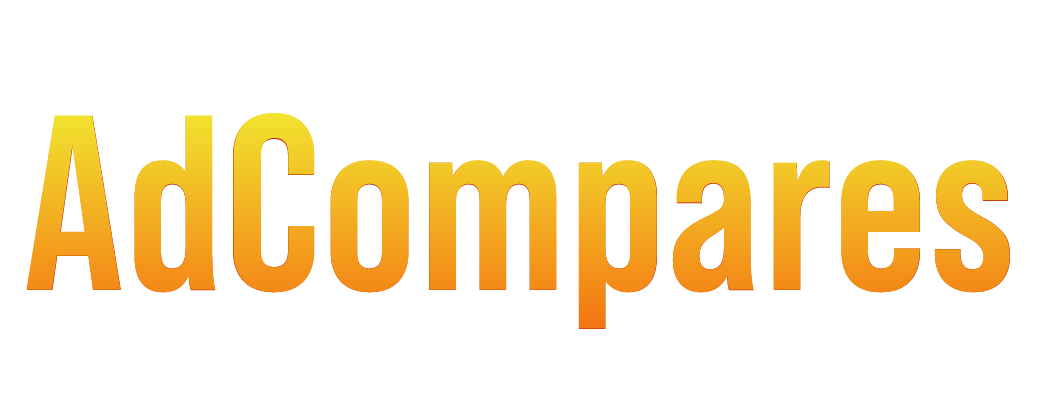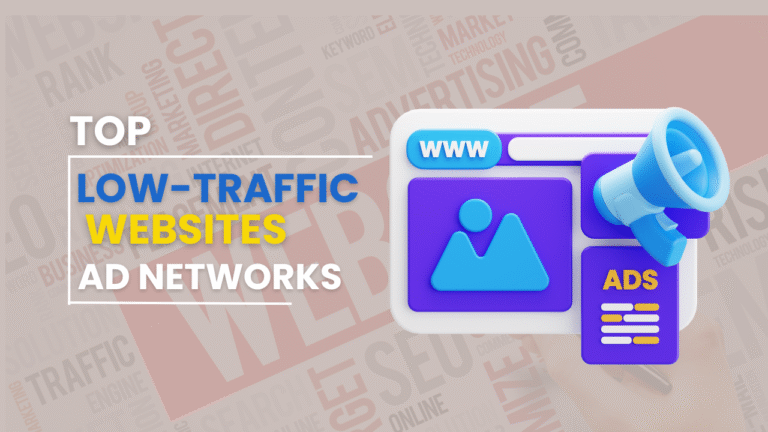Do you really need thousands of visitors every day to start making money from your website?”
The simple answer isno. Many beginner bloggers and small website owners believe monetization is only possible once they reach massive traffic numbers—but that’s no longer true. Today, several ad networks are built specifically for thelow-traffic websites, giving smaller publishers a fair chance to generate income without waiting years to grow.
Thanks to advancements in contextual targeting, native advertising, and AI-driven optimization, even a modest audience can bring in consistent ad revenue. Whether you run a personal blog, a niche content site, or a growing micro-community, there are ad networks that match your scale and help you earn from day one. In this article, we’ll explore thetop 10 best ad networks for low-traffic websites in 2026, breaking down their features, benefits, and suitability so you can find the perfect fit for your publishing journey.
Why Ad Networks Matter for Low-Traffic Websites
For small publishers, ad networks are often the very firstgateway to monetization. Most beginner website owners don’t have the connections or bargaining power to approach big brands for direct sponsorships. That’s where ad networks step in—acting as intermediaries that connect even the smallest publishers with global advertisers. By handling programmatic bidding, targeting, and ad placement automatically, these networks make it possible for low-traffic websites to earn without complicated negotiations.
Unlike premium ad networks that require50,000–100,000 monthly sessions, certain platforms are designed withsmaller publishers in mind. They accept websites with minimal requirements, sometimes as little asno traffic threshold at all, allowing niche bloggers and new site owners to start generating income right away. This accessibility is crucial because it turns a passion project or side hustle into a sustainable source of revenue much earlier.
Low-traffic websites especially benefit from networks that:
- Accept smaller publishers without strict traffic minimums – This ensures new bloggers don’t have to wait months or years before monetizing their content.
- Provide a fair revenue share and simple onboarding – Transparent payouts and easy setup give publishers confidence as they grow.
- Offer ad formats that blend well with niche content – For micro-niches, native ads, in-text ads, or contextual placements can feel less intrusive and more engaging.
- Ensure reliable and consistent payments – Since every dollar counts for smaller websites, dependable payment schedules are critical to building trust.
Ultimately,choosing the right ad network can mean the difference between earning pocket change and building a foundation for long-term growth. A smart selection not only boosts revenue but also teaches small publishers how to optimize ad placements, experiment with formats, and scale their websites into larger, more profitable platforms.
Key Considerations Before Choosing an Ad Network
Not every ad network is built for low-traffic websites, which means choosing the right one can feel overwhelming. Before signing up, small publishers should weigh a few critical factors that directly impact both earnings and ease of use. Rushing into the wrong network can lead to wasted time, poor ad experiences for readers, and even revenue loss. Here’s what matters most:
Traffic Requirements
Some ad networks haveopen-door policies and welcome publishers of all sizes, while others enforce strict minimum thresholds like10,000–50,000 monthly visitors. For a new or growing website, networks with little to no entry barrier are often the best starting point. This ensures you can begin monetizing immediately instead of waiting months to reach eligibility.
Ad Formats
Different formats work better for different audiences.Native ads blend seamlessly into content and perform well for blogs in lifestyle, health, or education niches.Display banners may work for broader audiences but often have lower engagement.Video ads can command higher CPMs, whilepop-unders or interstitials may bring quick revenue but risk hurting user experience. The right choice depends on your niche and how your readers prefer to consume content.
Payment Threshold & Methods
For low-traffic websites, waiting to reach a$100+ payout threshold can be frustrating. Networks withlow thresholds ($10–$20) allow publishers to access earnings sooner, which is especially motivating in the early stages. Also, consider payment options—PayPal, Payoneer, and direct bank transfers vary in convenience and fees depending on your location.
Audience Location
Advertiser demand is not equal worldwide. Networkstypically pay higher CPMs (Cost Per Mille) for Tier-1 countries, such as the U.S., U.K., Canada, and Australia, compared to Tier-2 or Tier-3 regions. If your traffic is mostly international, it’s important to choose a network that works well across geographies, not just U.S.-focused ones.
Ease of Setup & Optimization
Beginner-friendly platforms withintuitive dashboards, automatic ad placement, and optimization tools can save small publishers countless hours. Advanced features like AI-driven placement (offered by Ezoic, for example) allow bloggers to maximize revenue without needing technical expertise. For those with limited time or technical skills, simplicity is just as important as payout rates.
In short, the best ad network isn’t just the one that pays the most—it’s the one that matches yourcurrent traffic, niche, and growth goals. By evaluating these factors upfront, low-traffic publishers can avoid trial-and-error frustration and set themselves on the path to steady, scalable income.
Top Ad Networks for Low-Traffic Websites (2026)
Here’s the list which we’ll explore thebest ad networks for low-traffic websites in 2026, highlighting their features, strengths, and why they could be the right fit for your site.
- Google Adsense
- Media.net
- Ezoic
- Propeller Ads
- Infolinks
- Revcontent
- Mounmetric
- Adthrive (Now Raptive)
- Sovrn
- Amazon Publisher Services (APS)
1. Google AdSense
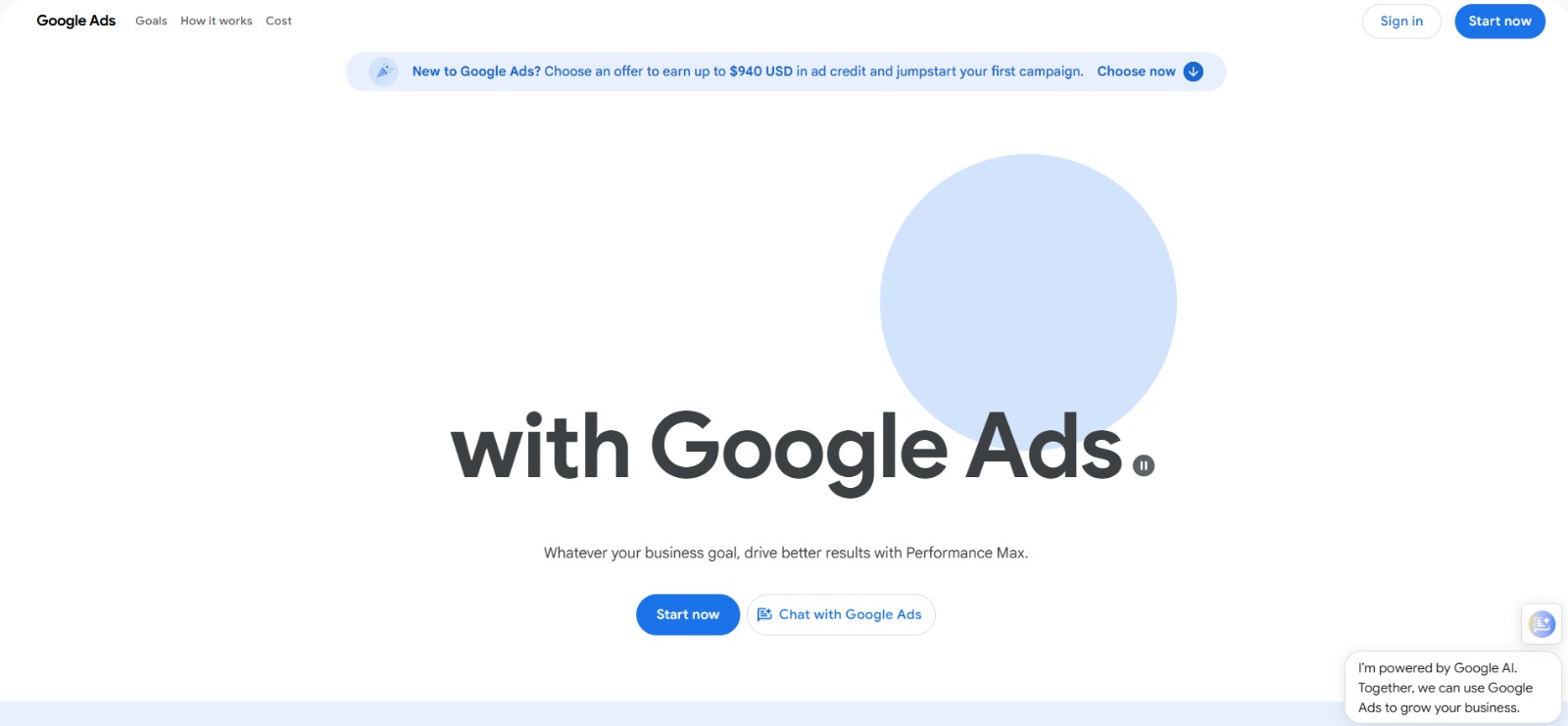
Google AdSense remains the most widely recognized ad network worldwide. With millions of advertisers in every possible niche, it ensures that even small publishers can display ads relevant to their audience. While approval can be selective, once approved, AdSense provides unmatched reliability, consistent payouts, and an easy-to-manage platform.
Key Features
- Massive Advertiser Pool: Since AdSense connects to millions of advertisers, websites of all kinds—from hobby blogs to educational platforms—can show relevant ads. This ensures a steady supply of ad inventory.
- Smart Auto Ads: Instead of manually placing ads, Google’s AI analyzes your website layout and automatically inserts ads in high-performing areas, improving revenue without extra effort.
- Multiple Ad Types: Publishers can choose from display ads, text ads, in-article ads, and matched content, giving them flexibility to balance earnings with user experience.
- Reliable Payouts: Known for its on-time monthly payments, Google AdSense is one of the most trusted monetization platforms.
Best For
Websites that have unique content, adhere to policies, and want a long-term, stable ad revenue stream. Especially ideal for bloggers planning to scale their traffic over time.
2. Media.net
Media.net is powered by Yahoo and Bing, making it one of the strongest alternatives to AdSense. Its contextual ad technology ensures ads blend naturally with the content, improving click-through rates. For publishers in premium niches like finance, health, and education, Media.net can often outperform AdSense in terms of earnings.
Key Features
- Contextual Targeting: Ads adapt to the keywords and themes of your content, making them more relevant to readers. For example, a finance blog will automatically show ads for investment services.
- High-Value Niches: Media.net excels in industries where advertisers pay high CPCs, such as insurance, finance, and technology. Even with low traffic, these niches can bring meaningful revenue.
- Fully Customizable Ads: Unlike rigid networks, Media.net allows publishers to change ad styles, colors, and placements so they look like a natural part of the site.
- Mobile Optimization: Since most traffic today comes from mobile devices, Media.net ensures ads load quickly and display correctly across all screen sizes.
Best For
Small websites in competitive niches (finance, health, education) where advertisers are willing to pay more for clicks.
3. Ezoic
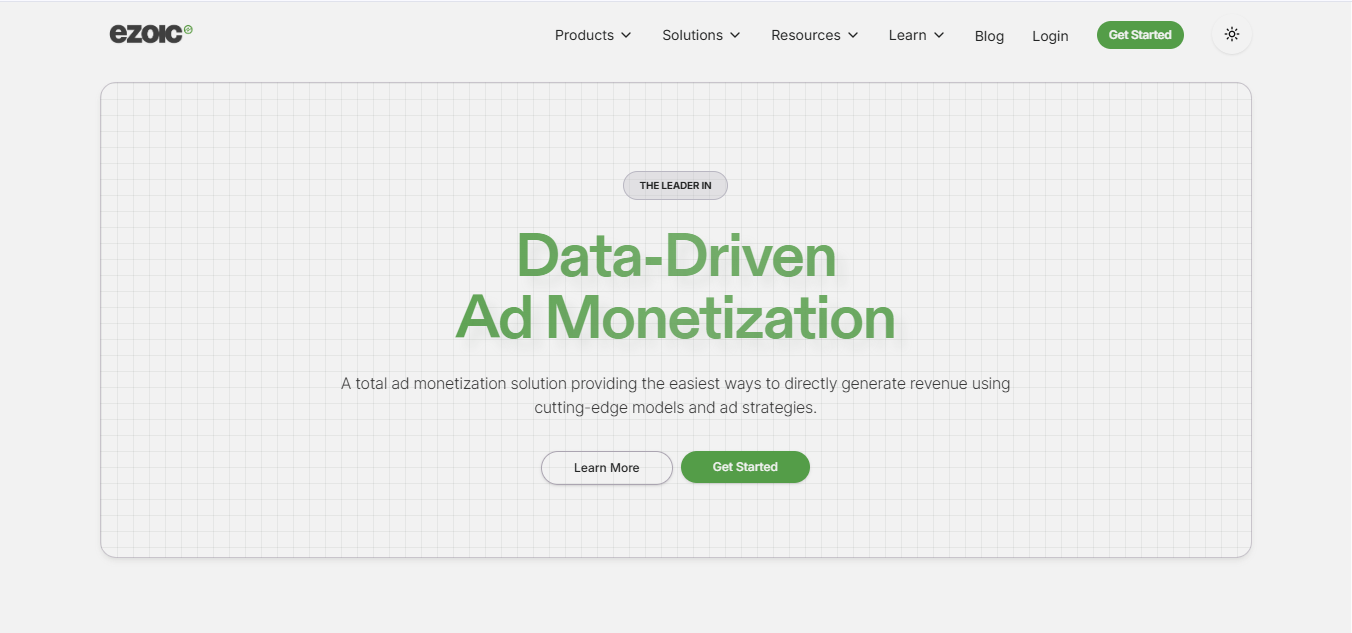
Ezoic is not just an ad network—it’s an ad optimization platform that uses artificial intelligence to test different layouts, placements, and networks. Even with modest traffic, Ezoic helps publishers find the most profitable setup without manual guesswork. Over time, it boosts revenue while also improving site performance.
Key Features
- AI-Powered Testing: Ezoic automatically experiments with ad positions, sizes, and combinations, learning which setups produce the highest earnings for your site.
- Access to Premium Advertisers: As a Google-certified publishing partner, Ezoic connects small publishers to high-paying ad exchanges they normally wouldn’t access.
- User Experience Tools: Features like Site Speed Accelerator ensure that ads don’t slow down your site, protecting your rankings and user satisfaction.
- Flexible Entry: While more features unlock as traffic grows, even low-traffic sites can benefit from Ezoic’s basic tools.
Best For
Bloggers who want to maximize every visitor and prefer a “hands-off” approach to ad testing and revenue optimization.
4. PropellerAds
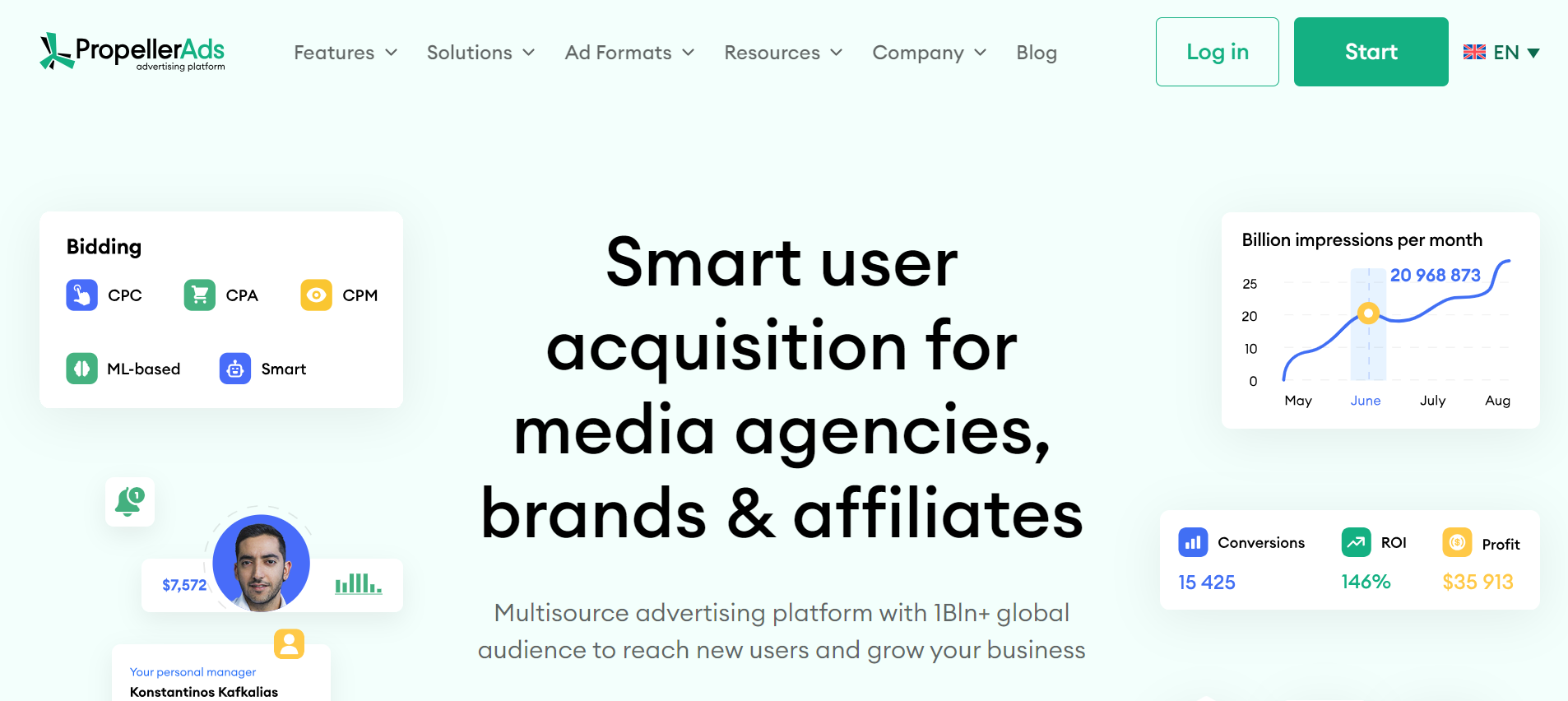
PropellerAds is one of the most beginner-friendly ad networks, offering quick approval and monetization options for websites with little to no traffic. Known for its innovative ad formats beyond traditional banners, it’s especially popular among entertainment and streaming websites.
Key Features
- Push Notifications: Visitors can subscribe to receive browser push ads, generating ongoing revenue even when they leave your site.
- Pop-Under Ads: Opens an advertiser’s page in a separate tab, ensuring high impressions without interfering too much with your site’s layout.
- Self-Serve Dashboard: With an intuitive interface, publishers can easily track performance and earnings without technical skills.
- Worldwide Coverage: Strong fill rates ensure ads are delivered to users globally, which is perfect for sites with mixed audiences.
Best For
Beginners who want fast approval and instant monetization, particularly for entertainment, gaming, or download-related sites.
5. Infolinks

Infolinks specializes in in-text and in-content ads that don’t require altering your site’s design. This makes it an excellent choice for low-traffic websites, as it monetizes existing content without overwhelming users.
Key Features
- In-Text Ads: Turns specific keywords in your articles into clickable ad links, which blend naturally with your writing.
- Multiple Ad Formats: Includes in-screen (overlay ads), in-tag (keyword targeting), and in-fold (banner ads), giving publishers flexibility.
- No Minimum Traffic Requirement: Makes it one of the most accessible networks for complete beginners.
- Quick Setup: With simple installation, websites can start running ads within hours.
Best For
Text-heavy sites like blogs, tutorials, and guides want ads integrated into content without being intrusive.
6. Revcontent
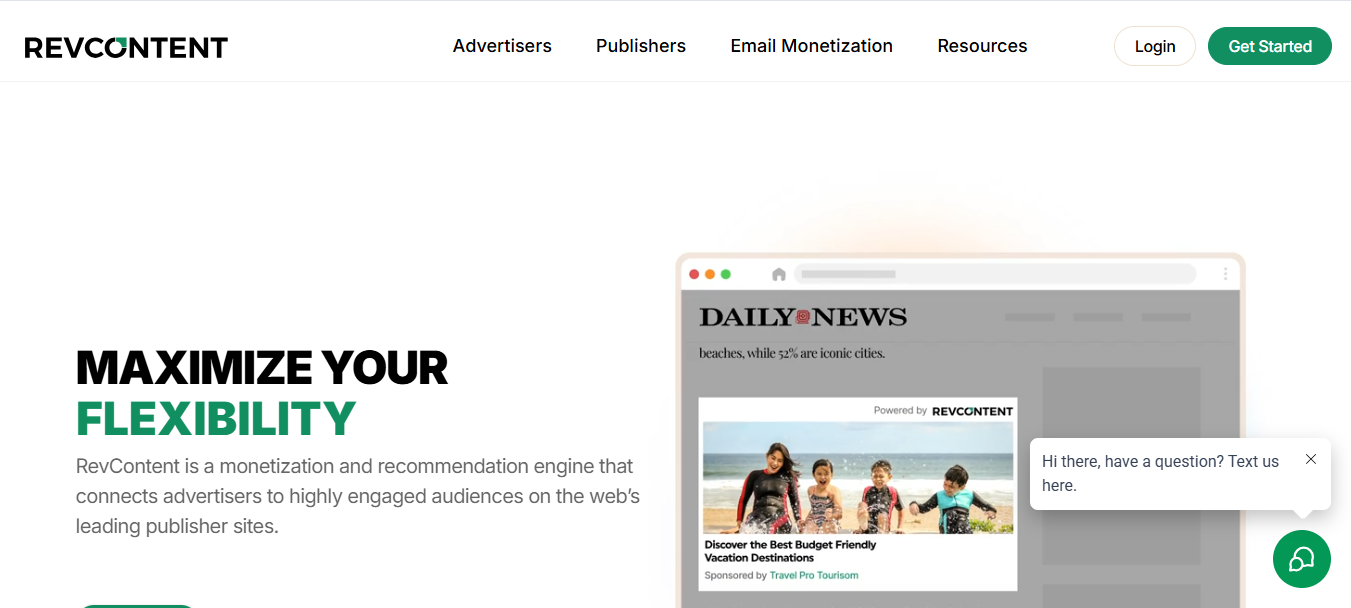
Revcontent is a native advertising platform that shows sponsored content recommendations at the end or within articles. Its ads are highly engaging because they blend with the site’s design, encouraging users to click without feeling like they’re leaving the website.
Key Features
- Native Advertising: Ads appear as recommended content, increasing user trust and engagement.
- High CPC Rates: Known for offering some of the highest payouts among native ad networks.
- Customizable Widgets: Publishers can adjust the look of ad units so they match their branding.
- Advanced Targeting: Helps ensure ads are relevant to readers, improving click-through rates.
Best For
Lifestyle blogs, news sites, or websites with article-heavy content that can naturally integrate native ads.
7. Monumetric
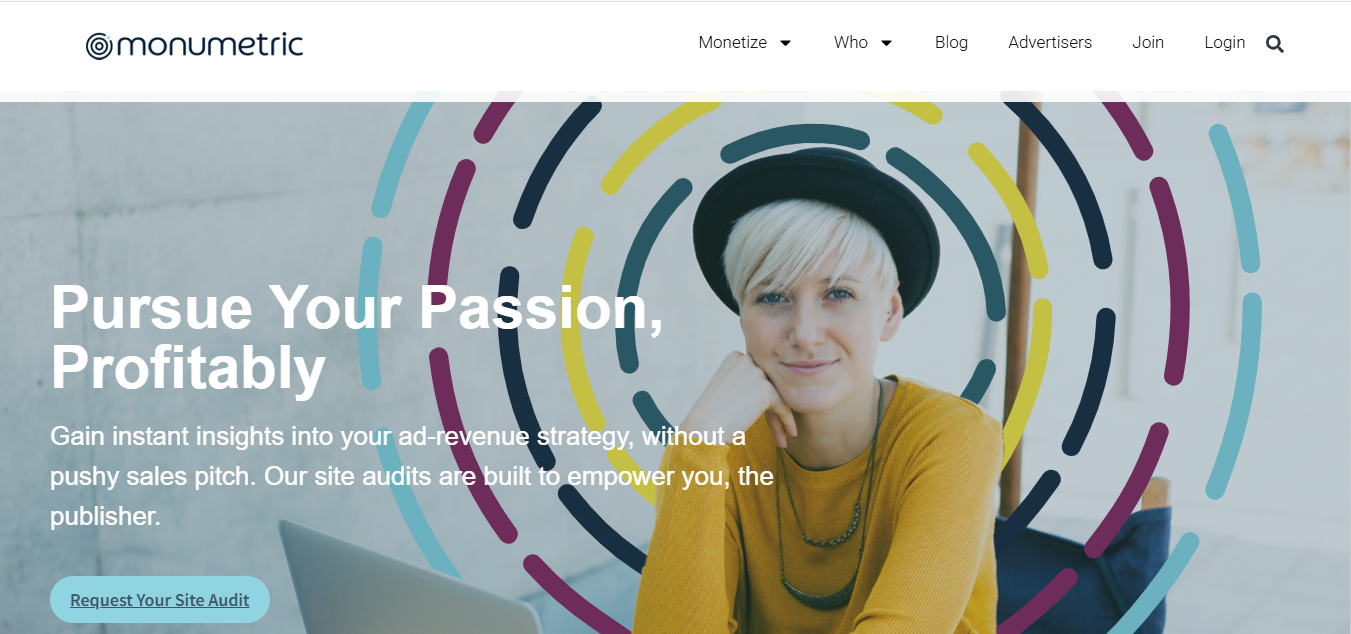
Monumetric (formerly known as The Blogger Network) is a publisher-friendly ad network that works closely with bloggers. While it requires at least 10,000 monthly views for approval, it provides hands-on support and access to premium advertisers that can significantly boost revenue.
Key Features
- Dedicated Account Managers: Each publisher is assigned support to help with ad placement, optimization, and performance tracking.
- High-Quality Ads: Focuses on partnerships with premium advertisers, which results in better-quality ads and higher payouts.
- Flexible Placement Options: Works well with blogs, recipe sites, and content-heavy websites.
- Transparent Reporting: Provides detailed insights into earnings and ad performance.
Best For
Growing blogs with consistent traffic that want professional-level support and optimization without having to join bigger networks like Mediavine.
8. Sovrn
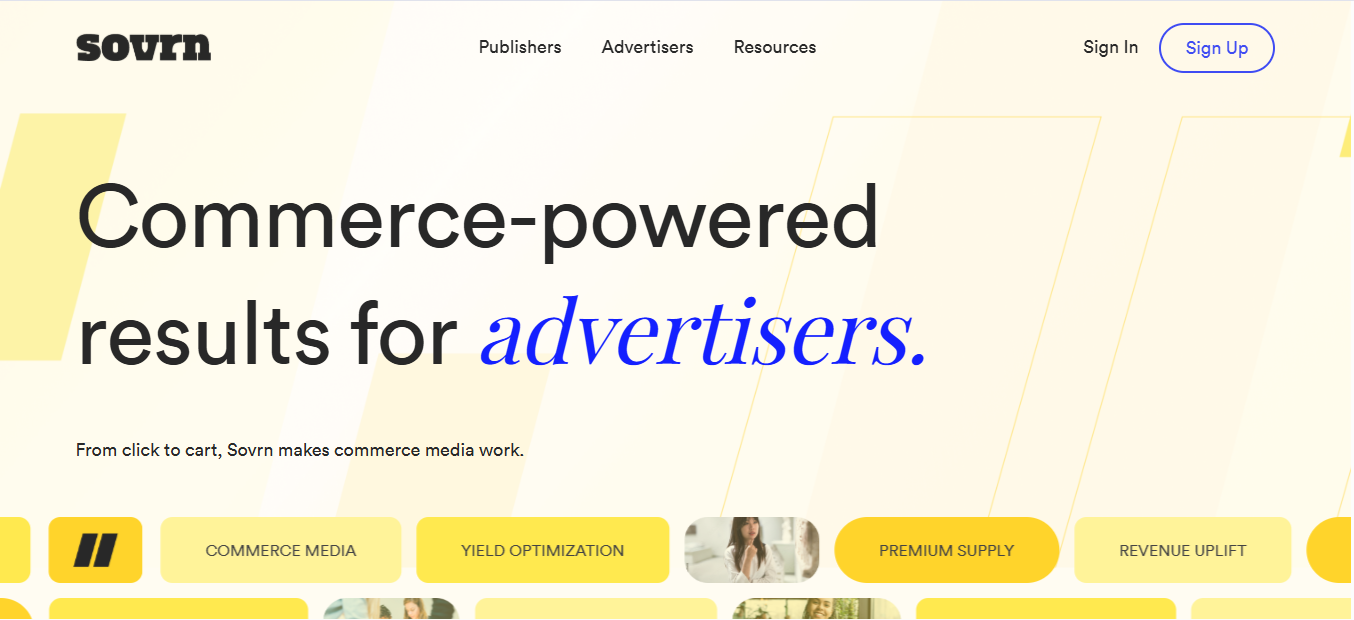
Sovrn is unique because it combines display ads with affiliate monetization. Even if you have low traffic, its //Commerce tool automatically turns product mentions in your content into affiliate links, creating multiple income streams from the same article.
Key Features
- Automatic Affiliate Linking: Mentions of brands or products in your posts are automatically linked to affiliate programs, saving time and boosting revenue.
- Display + Affiliate Combo: Unlike many networks, Sovrn lets you earn both from traditional display ads and affiliate commissions simultaneously.
- Detailed Analytics: Gives insights into which products or links your readers click most, helping refine your content strategy.
- No Minimum Traffic Requirement: Makes it accessible to small publishers right from the start.
Best For
Blogs that review products, write tutorials, or create niche guides where product mentions are natural.
9. AdThrive (Now Raptive)
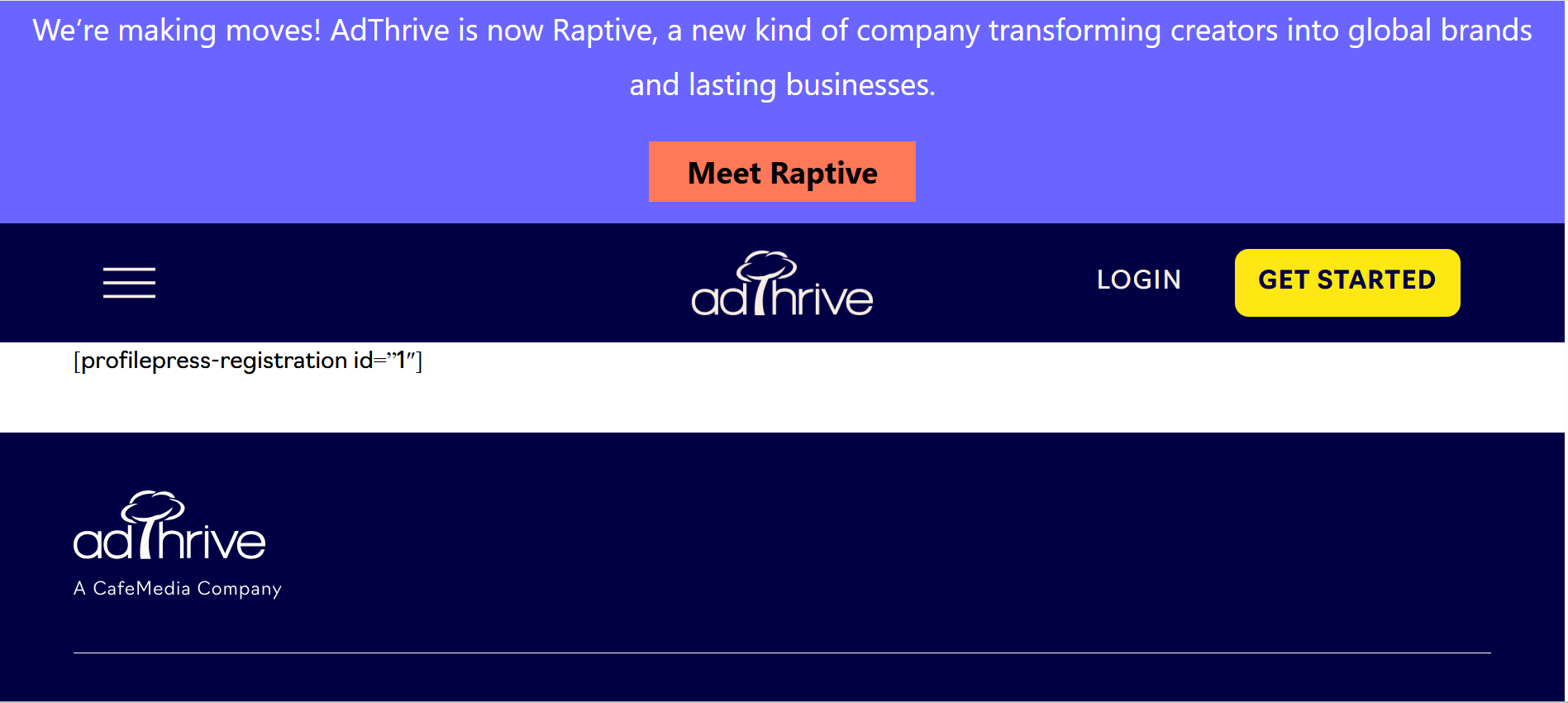
AdThrive, now rebranded as Raptive, is one of the most premium ad networks in the blogging world. While it usually requires higher traffic (100k+ monthly sessions), it’s worth mentioning because many small publishers aspire to qualify as they grow. It focuses on lifestyle, parenting, travel, and food niches.
Key Features
- High RPMs: Known for offering some of the highest revenue per thousand views (RPMs) in the industry.
- Dedicated Publisher Support: Every site gets access to hands-on support for ad setup, troubleshooting, and optimization.
- Brand-Safe Partnerships: Works only with premium advertisers, ensuring high-quality ads that don’t harm your site’s reputation.
- Advanced Video Monetization: Offers native video players with ad support, which boosts engagement and income.
Best For
Bloggers aiming to scale big in lifestyle, food, parenting, or travel niches. Not ideal for very new blogs, but a strong goal for future growth.
10. Amazon Publisher Services (APS)
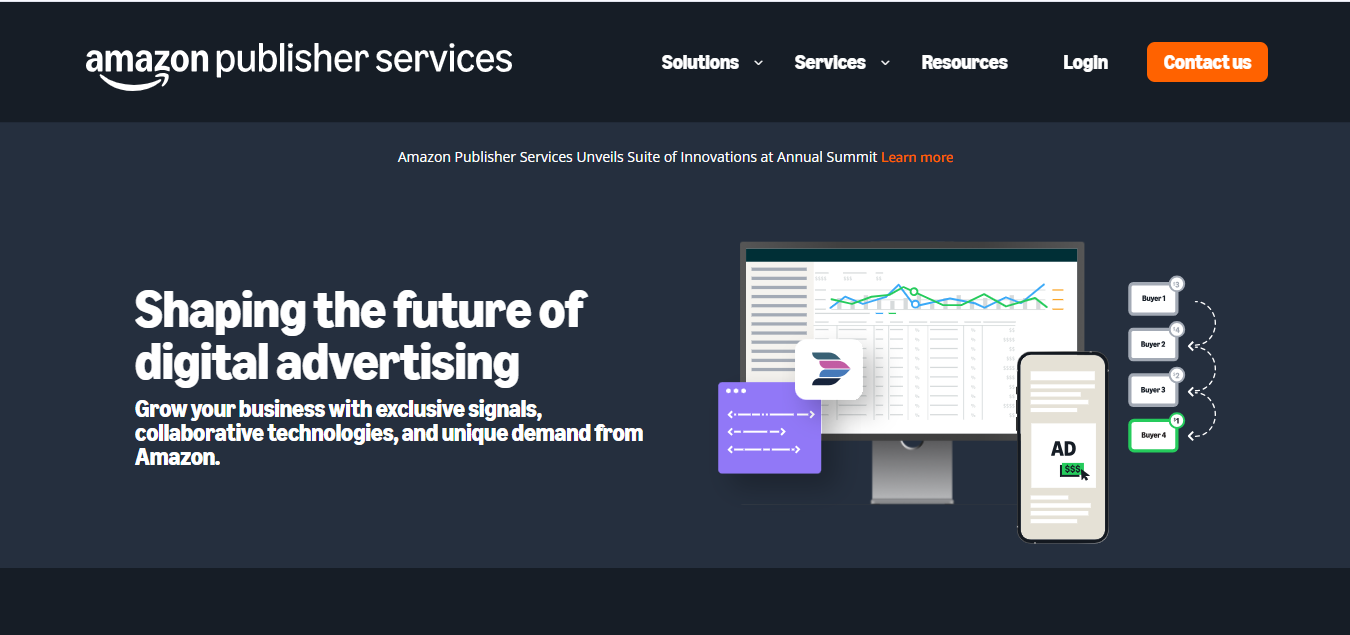
Amazon Publisher Services allows websites to display high-quality, programmatic ads backed by Amazon’s massive advertiser base. Even smaller sites can benefit from Amazon’s global demand, and integration is smooth if you already participate in Amazon Associates (affiliate program).
Key Features
- Access to Amazon Advertisers: Tap into Amazon’s vast ecosystem of sellers and brands who are eager to promote products.
- Transparent Reporting: Real-time dashboards help track impressions, clicks, and revenue clearly.
- Unified Ad Marketplace: Combines demand from multiple sources, ensuring strong fill rates even for smaller sites.
- Seamless Integration: Works well alongside Amazon Associates, letting bloggers earn from both ads and affiliate links.
Best For
Product-focused websites, review blogs, and eCommerce-related niches that want to leverage Amazon’s global advertiser demand.
From Low Traffic to Steady Income
Monetizing a small website may feel like a slow climb, but the right ad network can transform even modest traffic into meaningful income. Starting with beginner-friendly platforms likeInfolinks orPropellerAds helps you take the first step, while growth-oriented options likeEzoic andMedia.net prepare you for long-term success. If you can meet the requirements,Google AdSense still stands as one of the most trusted choices in the industry.
The real secret lies in experimentation—testing different networks, tracking performance, and adjusting placements until you find what clicks with your audience. Every visitor counts, and with consistency, even a low-traffic site can evolve into a reliable source of revenue.
Conclusion
Choosing the best ad network for a low-traffic website depends on your niche, audience behavior, and long-term goals. Some networks, like Google AdSense and Media.net, are beginner-friendly and offer quick approval, while others, like Ezoic or Amazon Publisher Services, provide advanced optimization and higher earning potential as your site grows. The key is to start with a network that supports your current size but also offers room to scale.
In the ever-changing world of digital advertising, low-traffic websites no longer need to struggle with poor monetization. By leveraging the right ad network, even micro-publishers can enjoy steady revenue, better ad quality, and a more engaging reader experience. The future of blog monetization lies in finding the balance between earnings and user satisfaction—and these ad networks make that possible, even if you’re just starting your journey.
Frequently Asked Questions(FAQs)
Can low-traffic websites really earn money with ads?
Yes, they can. Earnings might start small, but even websites with a few thousand monthly visits can generate revenue if they choose the right ad networks. The trick is to go with platforms that don’t have strict entry requirements and that offer flexible, user-friendly ad formats. This way, you can monetize your audience while steadily growing traffic over time.
What’s the minimum traffic required for most ad networks?
Some networks are very beginner-friendly and don’t require a minimum traffic count at all—Google AdSense, Infolinks, and PropellerAds are good examples. Others, like Monumetric, have higher thresholds, usually around 10,000 pageviews per month. It’s important to check the eligibility criteria before applying so you don’t waste time.
Which ad formats perform best for small sites?
Smaller websites often see better results with native ads, in-text ads, and push notifications. These formats integrate naturally with your content and attract user engagement without being overly disruptive. Traditional banner ads, on the other hand, may not perform as well if your impressions are limited.
Is Google AdSense the best option for beginners?
AdSense is often the first choice because of its reliability and ease of use, but it’s not always the top earner. Depending on your niche and audience location, platforms like Ezoic or Media.net might bring in higher RPMs. The smart move is to test different networks and see which delivers the best results for your site.
How much can a low-traffic site earn monthly?
A site with 5,000 to 10,000 monthly visitors might earn anywhere from $10 to $100, depending on traffic geography, niche, and ad formats used. While this isn’t huge money, it’s an excellent stepping stone. As your traffic scales, so will your earnings.
Do these networks support international traffic?
Most of them do. PropellerAds, Adsterra, and HilltopAds, for instance, cater to global audiences. However, some networks, such as Media.net, offer the best performance when most of your traffic comes from the U.S. and Canada. Knowing where your audience is located can make a big difference in choosing the right network.
Can I use multiple ad networks on the same website?
Yes, combining networks can actually help boost your income. For example, running AdSense for display ads while using Infolinks for in-text ads ensures both formats complement each other. Just make sure the networks you choose are compatible and don’t violate each other’s policies.
What’s the best way to increase revenue from ads?
The most effective strategy is to focus on traffic quality, not just quantity. Experiment with different ad placements, formats, and layouts to see what performs best. Over time, you can also supplement ad income with affiliate marketing, sponsored posts, or direct partnerships to diversify your revenue.
